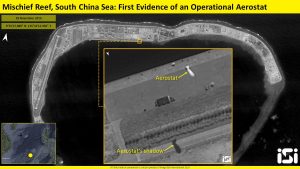Recently published satellite images indicate that China may have deployed a tethered aerostat to Mischief Reef, the site of one of its artificial island bases in the Spratly Islands in the South China Sea.
In an image taken on November 18 by an Israeli satellite firm, ImageSat International, an apparent stationary aerostat appears visible on the northern side of Mischief Reef. Mischief Reef is China’s largest outpost in the Spratly Islands.
In separate images taken by Planet, Inc., another imagery firm, the aerostat appears to be visible at the same location at Mischief Reef after November 16. Chinese authorities have not confirmed the deployment of an aerostat to the disputed South China Sea feature.
Officials from regional states, including South China Sea claimant states, have not commented on the deployment of any new capabilities by China to the South China Sea recently. Neither have U.S. officials.
Little is known in the public domain about China’s indigenous military aerostats, but these systems are likely designed to augment the surveillance capabilities currently in place at Mischief Reef.
Low-altitude tethered aerostats can contribute to situational awareness and intelligence, surveillance, and reconnaissance (ISR) capabilities. Depending on the sensors on board, these systems can allow ground crews based at Mischief Reef to have better domain awareness in the surrounding waters.
Sensor data from aerostats can be correlated and linked to other systems, including terrestrial over-the-horizon radars. Given their low cost of operation, aerostats can prove to be a useful platform for monitoring a large area of sea, ground, or airspace.
In the United States, an aerostat-based ISR platform known as the Joint Land Attack Cruise Missile Defense Elevated Netted Sensor System, or JLENS, was developed in the 1990s specifically to deal with low-flying cruise missile threats.
The JLENS platform could also track boats, ground vehicles, and some types of aircraft. The American JLENS program was suspended in October 2015 after one JLENS aerostat came untethered.
Mischief Reef has been a common site for the U.S. Navy‘s freedom of navigation operations. In November, USS Gabrielle Giffords, an Independence-class littoral combat ship, sailed near the feature to protest excessive Chinese maritime claims. Separate freedom of navigation operations near Mischief Reef were reported to have taken place in August 2019, February 2019, and March 2018.
The United States has criticized China’s gradual militarization of its artificial island features in the South China Sea. In recent years, including Mischief Reef, China built seven artificial islands in these disputed waters.

































